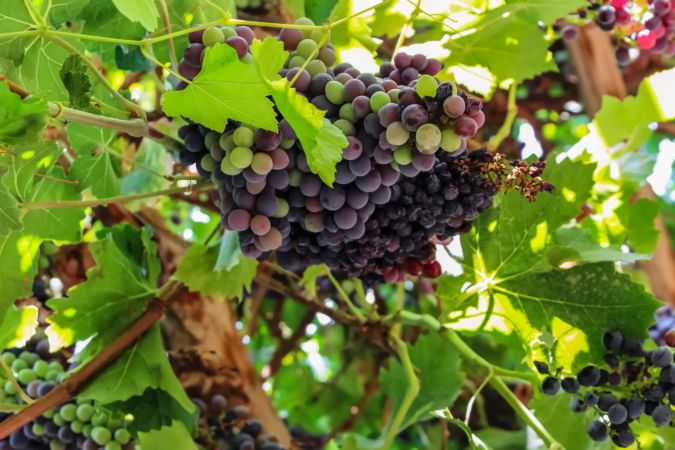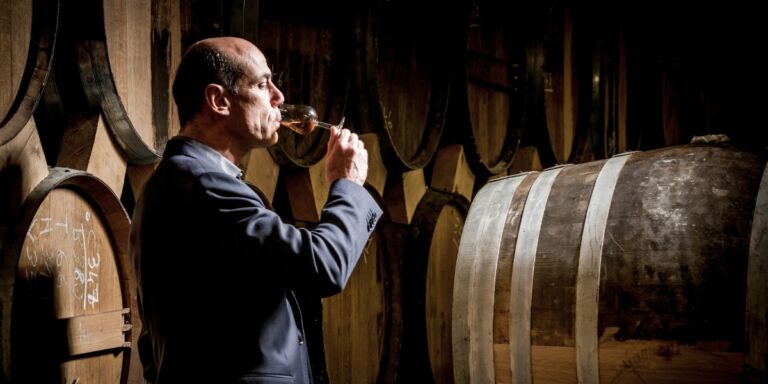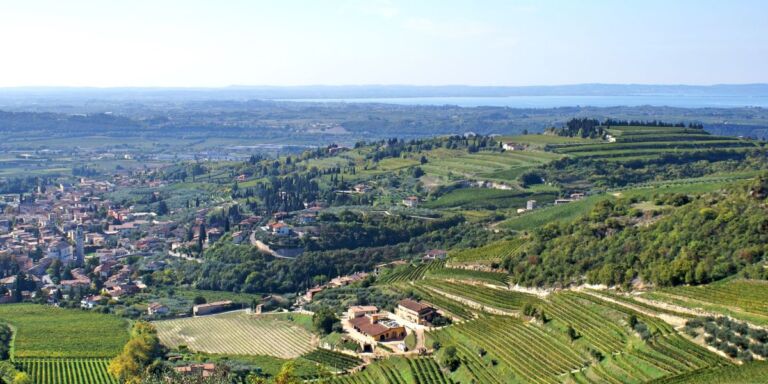The perception of Chinese wine among younger generations in China has changed a lot and in a very short time. Over the past decade or so, domestic wines have lost market share to imported wines, but now they’re picking up momentum thanks to regained confidence among Chinese consumers.
Having a bottle of home-grown wine on the dinner table now looks up-to-date rather than old-fashioned; indeed, it shows an appreciation of wine. With China now one of the world’s biggest wine-producing countries, it’s just a matter of time before that attitude catches on internationally.
It’s time to get better acquainted with the history and the current landscape of Chinese winemaking, the country’s main varieties and regions, and what lies ahead for China’s wines.
Jump straight in to our guide to Chinese wine…
A brief history of Chinese wine
Wine hasn’t played a major part in the course of Chinese history. During the Han and Tang dynasties, wines mainly appeared in poems about conquering the West, or were introduced to monarchs out of curiosity or during banquets. More recently, the leaders of the new China treated wine as a diplomatic tool, a symbol of friendliness to other countries.
Pre-1990s, wine production was not sophisticated: the best-known brands for domestic wines, Changyu and Great Wall, generally made wine by blending partly fermented grape juice with flavourings.


It wasn’t until the end of the 20th century that Chinese consumers started taking a close interest in the lifestyles of the West. Wines, cuisines, fashion and more were introduced to the lives of the Chinese.
The first batch of new Chinese wineries appeared in the 1990s; when China joined the World Trade Organization in 2001, there was a flood of imported wine. This opened up the Chinese market and educated consumers, leading to the realisation that there could be great potential within the Chinese industry.
With support and promotion from local governments, the wine regions and wineries have grown rapidly over the past decade, resulting in the planting of some 120,000 hectares of vineyards, the development of eight large-scale regions, and more than 200 wineries. This transformation has propelled China into the top 10 of the world’s biggest wine-producing countries.

What are the main grape varieties in China?
The main red grape varieties grown in China include Cabernet Sauvignon, Merlot, Cabernet Gernischt and Marselan; a handful of vineyards have grown Syrah, Pinot Noir, Saperavi, and Malbec.
Cabernet Sauvignon is the core red grape variety, and has the largest area under vineyard (approximately 30,000 hectares), from the Shangri-La in Yunnan at an altitude of 2,200 metres to the Yanqi Basin at the foot of the Tianshan Mountains in Xinjiang, and to the coastal Penglai in Shandong.
The industry is young and producers are still working towards finding Cabernet’s unique expression in the different terroirs; at the same time, many producers are following the current trend for single-variety wines.
Over the past five years, Marselan has been so widely planted it is now second only to Cabernet Sauvignon
There’s also a movement to find a signature grape to give the Chinese wine industry a point of difference. For a while, the greatest hope was Cabernet Gernischt, the descendant of Cabernet Franc that arrived in Shandong in the late 19th century.
But lately, the focus has shifted to Marselan, which originated on the French Mediterranean coast and was planted in China’s Hebei region as a collaboration between the Chinese and French governments. Over the past five years, Marselan has been so widely planted it is now second only to Cabernet Sauvignon.

Among the white varieties, the most common grape is Chardonnay (15,000 hectares), followed by Petit Manseng, Riesling, Welschriesling, Viognier and Vidal. As with Cabernet Sauvignon, Chardonnay is planted in every wine region in China. This excellent variety has quickly adapted to China’s climate and terroir, and produces outstanding wines.
The only issue is that Chinese consumers prefer red wines (reds represent 90% of wine sales in China), a situation which has plunged Chardonnay into a price war; some producers are now considering replacing the grape with other varieties.
For example, some wineries from the Hebei’s Huailai region are replanting Riesling and the Chinese specialty grape Longyan, while other producers in the Penglai region are placing their hope on Petit Manseng.
What are the major wine-growing regions in China?

Ningxia
In terms of international recognition, Ningxia is the best-known Chinese wine region. This arid, central-northern region is protected from the north-westerly weather by the Helan Mountains, while the Yellow River provides irrigation. With an altitude above 1,000 metres and more than 3,000 hours of sunshine, Ningxia’s terroirs produce grapes with concentrated flavours, high alcohol levels and strong tannins.
Economically, the region receives support from local government in terms of land resources, infrastructure and marketing promotions. This has attracted talent and investors, enabling Ningxia to become one of the most dynamic regions, with more than 100 wineries, including the wine giant Changyu group’s flagship Château Changyu Moser XV, the garage winery Silver Heights, Legacy Peak, and Domaine des Aromes – the first winery to start biodynamic practices – and the premium Jade Vineyard.
In 2013, the Ningxia government introduced a classification system, grading wineries into five quality tiers, reassessed every two years – the first of the top-tier wineries is expected to be announced in 2021.
Xinjiang
With its diverse soils and favourable climate producing Cabernet Sauvignon and Chardonnay strong in fruit and mineral flavours, Xinjiang is considered a paradise for grape-growing by the Chinese. Other grapes such as Syrah and Marselan do well here, while two particular areas of Xinjiang, the Manas Basin and Yanqi Basin, have seen the growth of a number of boutique wineries, some of which have had some success with eastern European varieties such as Rkatsiteli and Saperavi.
Shandong
Shandong has the longest winemaking history in China, but unfortunately, the humid and rainy summers have kept down the growth of winemaking, with local farmers focusing on more economically reliable industries instead.
Despite this, Shandong’s warmer climate gives it an advantage over Xinjiang and Ningxia – for example, wineries don’t need to bury their vines to protect them from harsh winters, as they do in those high regions where winter temperatures can plunge to minus 15˚C and below.
As a result, Shandong has attracted the likes of Domaines Barons de Rothschild (Lafite) to Penglai on the eastern Shandong peninsula. White grapes from Shandong are influenced by the maritime climate, making clean, fresh, fruity wines, with crisp acidity and hints of minerality. As for the reds, the two dry summers of 2018 and 2019 helped Shandong to catch up with Ningxia and Xinjiang’s winemaking reputations.
Hebei
Hebei province near the capital Beijing has historically been at the centre of political diplomacy, so it has a long-standing wine tradition. In the 1980s, as China started to open up to the outside world, a research team was put together in Hebei to produce dry wines in an international style to serve to foreign diplomats. In 1997, China and France established their joint venture – the Sino French Demonstration Vineyard – in Hebei, introducing plantings, vines, equipment and technology from France.
Wine production in the hilly Huailai region in Hebei is rapidly growing. Close to the Great Wall of China and Beijing, one of its best-known producers is the Great Wall Wine company, which was founded in 1983 and was the official wine of the 2008 Beijing Olympics.
Huailai has a cool, dry climate, many mature vineyards and a pool of winemaking talent. It is this region that produces China’s most elegant Pinot Noirs and Merlots, and China’s most expensive Marselan – Domaine Franco-Chinois Marselan Reserve, which retails at RMB1,200-1,600 (£130-£175) per bottle.
Yunnan
At over 2,000m above sea level, Yunnan is one of the world’s highest vineyard areas. French missionaries arrived in Tibet and the remote Deqin and Cizhong regions near Yunnan 150 years ago, establishing churches and also planting vineyards. Catholicism took hold over the next 100 years and is evident in the number of practising Catholics in the region to this day.
The wineries here are scattered in the valleys of the Mekong and Dadu rivers. The smallest vineyards might grow no more than 10 vines (there are a few pockets of very old vines), but its long ripening period, high altitude, and warmer winters (with no need to bury vines), plus its excellent growing environment has attracted major investors. These include the LVMH group, which produces Ao Yun, one of China’s most celebrated (and expensive) wines, from vineyards 2,600m high.
Another new French venture is Xiaoling, which is made under the auspices of Sylvain Pitiot of Burgundy’s Clos de Tart with the Burgundy-trained Chinese enologist Mu Chao.


Shanxi
Other regions such as Shanxi produce far less wine but have a reputation for the quality of their Cabernet Sauvignon and Merlot blends. The best example is Grace Vineyard set up by Chan Chun-Keung in 1997. Changyu is the biggest wine producer in this region, owning more than 300 hectares of vineyards.
Similarly, high-quality Pinot Noirs are being produced in the southern part of Gansu, in high-altitude vineyards – they are dominated by four wineries: Mogao, Dunhuang, Zixuan, and Qilian.
What’s the future for Chinese wine?
Chinese wine consumers now know more about wine than ever before – in 2019, China was the Wine & Spirit Education Trust’s second-largest market. They now have good access to more tastings, and find themselves with more disposable income to spend on wine. Not just that, but they’re able to do this in more places than ever – via both bricks-and-mortar retailers and online.
The biggest domestic players – Changyu and Great Wall Wine – have started to focus on their own vineyards, with the former expanding their Ningxia Château Changyu-Moser XV into international markets, and the latter hiring world-renowned consultant Michel Rolland to take the Hebei Château Sungod Great Wall to the next level.

Some small- and medium-sized boutique wineries in China are starting to gain popularity among Chinese wine consumers, such as Silver Heights Vineyard and Helan Qingxue Vineyard in Ningxia, Tiansai Vineyards and Puchang Vineyard in Xinjiang, and Shanxi’s Grace Vineyard.
Independent winemakers are starting to make their presence felt
All have put huge effort into viticulture and winemaking, such as replanting cuttings, improving irrigation and using new oak barrels sparingly – thereby expressing their terroir while improving quality. At the same time, organic, biodynamic, and other natural winemaking styles are quietly making their mark.
What makes it an exciting time for Chinese wine is that some independent winemakers such as Deng Zhongxiang, a consultant who also makes wine for a handful of producers, Ma Jie, the wine tech director at Jade Vineyard, and low-intervention winemaker Ian Dai are starting to make their presence felt in Yunnan and Ningxia. They are producing excellent wines full of character, buying grapes they like and renting equipment.
The industry as a whole still has many issues to be resolved, however, such as how to make wineries more economical, and how to resolve the thorny issue of a lack of young winemaking talent.
Currently in China, there are already more than 10 wineries with second-generation owners in Ningxia, and Silver Heights has already started to groom its third-generation owner. Most owners of small- and medium-sized wineries only came to wine later in life, and founded their wineries after a change in career, and most are already in their 50s, 60s, or even 70s.
Generally speaking, the owners’ children have been sent abroad to further their studies, and have no plans to study wine or work in the industry. It is proving to be an ongoing struggle, with many families keen for their children to return to continue their good work.
But China is no stranger to such issues. Just as Deng Xiaoping, the man responsible for China’s reform under the “one country, two systems” principle, once said: “The problems arising from development must be solved through development.” It will be fascinating to see how China rises to the challenge.

Terry Xu is a wine and cognac expert based in China, and a senior wine business consultant with 23 years of experience in the industry.
This article was translated from Chinese to English by Beatrice Ng.







